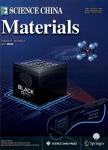机器学习原子运动揭示金属玻璃塑性起源:从热塑性到超声塑性
Machine learning atomic dynamics to unfold the origin of plasticity in metallic glasses:From thermo-to acousto-plastic flow作者机构:College of Mechatronics and Control EngineeringShenzhen UniversityShenzhen 518060China Guangdong Key Laboratory of Electromagnetic Control and Intelligent RobotsShenzhen UniversityShenzhen 518060China Department of Mechanical EngineeringCollege of EngineeringCity University of Hong KongKowloon TongKowloonHong Kong SARChina School of Materials Science and EngineeringTongji UniversityShanghai 201804China Shanghai Engineering Research Center of Physical Vapor Deposition(PVD)Superhard Coating and EquipmentShanghai Institute of TechnologyShanghai 201418China Department of Materials Science and EngineeringCollege of EngineeringCity University of Hong KongKowloon TongKowloonHong Kong SARChina
出 版 物:《Science China Materials》 (中国科学(材料科学(英文版))
年 卷 期:2022年第65卷第7期
页 面:1952-1962页
核心收录:
学科分类:08[工学] 081104[工学-模式识别与智能系统] 0805[工学-材料科学与工程(可授工学、理学学位)] 080502[工学-材料学] 0703[理学-化学] 0811[工学-控制科学与工程] 0702[理学-物理学] 0812[工学-计算机科学与技术(可授工学、理学学位)]
基 金:supported by the National Natural Science Foundation of China(52071217) Guangdong Key Laboratory of Electromagnetic Control and Intelligent Robots。
主 题:metallic glass plasticity machine learning molecular dynamics simulation
摘 要:金属玻璃具有无序的原子排列,但其结构与动力学并非各处均匀.许多研究证实金属玻璃的结构与动态不均匀性对于其塑性机制至关重要.金属玻璃的缺陷被视为结构上疏松排布、动力学上积极响应外界刺激的区域.但迄今仍未建立明确的结构-性能关系来甄别金属玻璃中的类液缺陷.本文中,我们基于模拟原子运动轨迹并结合机器学习提出了一种不依赖于静态结构特征的缺陷.利用k近邻机器学习模型分析并预测了不同温度下的原子运动行为,建立了温度类标签-原子运动特征映射关系.应用这个机器学习温度参数理解金属玻璃在应力下的塑性流,识别类液区原子.类液区的演化揭示了金属玻璃塑性的动态起源(包括热塑性和超声塑性),展示了应力诱发的非均匀性和原子局域环境的关联,为热塑性成型和超声加工提供了新见解.



